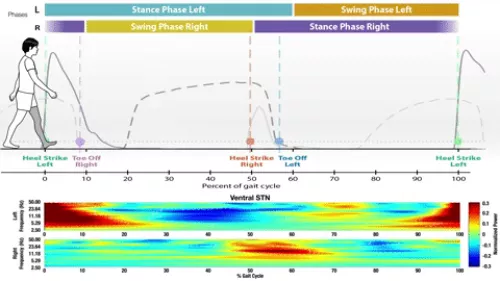Current treatments for Parkinson’s disease – like dopamine replacement therapy and deep brain stimulation – do not always resolve the difficulty many patients have walking.
Gait disturbances remain challenging to treat without a complete understanding of how the human brain regulates the complex, dynamic process of walking. But now Doris Wang, MD, PhD, an assistant professor in the Department of Neurological Surgery at UC San Francisco, has received a new NIH grant to investigate the coordination between different areas of the brain during walking.
“We have an unprecedented opportunity to first figure out the neural control of gait in humans,” Wang said.
Her research involves monitoring the brain activity in ten people with Parkinson’s disease using subdural electrocorticography (ECoG) electrodes covering the premotor and motor cortex and deep brain stimulation leads in another part of the brain called the globus pallidus. These recordings on both hemispheres of the brain – when paired with measurements from motion-tracking sensors – will allow the researchers to determine how the electrical signals between regions synchronize during various stages of walking.
For example, people with Parkinson’s disease typically have problems getting started walking, which necessitates a shift in posture that changes their center of mass. Wang thinks that this transition may require active coordination between different parts of brain.
“That communication might be broken in patients with Parkinson's disease and make those changes difficult,” Wang said.

On the other hand, Wang suspects that continuous walking is more automatic, with less input from the motor cortex.
Changing direction and navigating obstacles like doorways or uneven surfaces is also tough for people with Parkinson’s disease. Wang says that external cues can often trigger episodes known as freezing of gait – when the feet suddenly stop moving while the body is still going forward.
Wang wants to figure out what happens to the neural activity during these periods when a person needs to adjust their step. She and her colleagues have developed a test where patients must change their step length to step on a target while walking on a treadmill. The scientists can then observe the movement as the individual swings their foot, looking for any changes in brain activity that allow them to adjust their gait pattern.
The new technology, when paired with home wearable sensors, Wang says, makes it possible for the researchers to study gait outside of laboratory settings too.
“The dynamics of walking on a treadmill versus freely moving in the environment are really, really different,” Wang said. Patients in the lab are usually paying more attention to how they are walking, which can sometimes make phenomena like freezing of gait more difficult to capture, Wang says. Patients participating in this study will have various gait tasks to work on at home while streaming the neural data from their deep brain stimulation device.
The home recordings, Wang says, will capture natural fluctuations in the patients’ medication cycle, enabling the researchers to compare more effective walking states more symptomatic walking states.
Wang is currently the principal investigator of a clinical trial sponsored by the Michael J. Fox Foundation that uses adaptive deep brain stimulation to improve gait function in Parkinson’s disease. “Seeing on the clinical side, what diseases and symptoms patients are afflicted by drives my research,” she said.
These studies, she says, could offer new insights on how to adjust the timing of electrical signals in deep brain stimulation therapy.
And as an early career faculty member supported by the Burroughs-Wellcome Fund, Wang says the new NIH funding provides the momentum to expand her research group.
